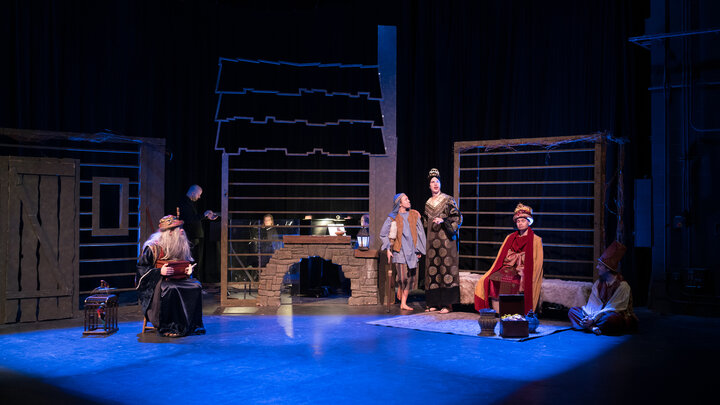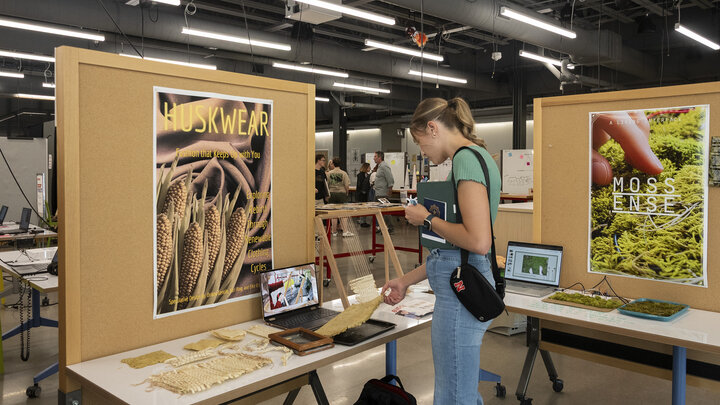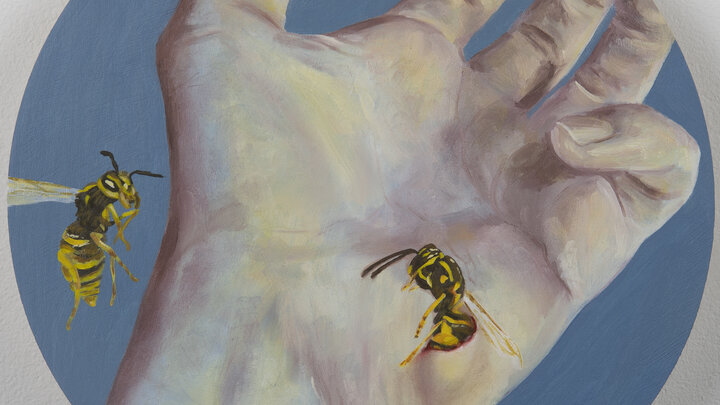Lincoln, Neb.--Amy Sanders, a second-year ceramics graduate student in the School of Art, Art History & Design, had a productive summer with the publication of an article in Ceramics Monthly and the completion of a residency at the Shigaraki Ceramic Cultural Park in Japan.
“I’ve barely begun to kind of reflect and process everything,” Sanders said.
Associate Professor of Art Margaret Bohls said Sanders had an “outstanding” first year at Nebraska.
“She produced two large bodies of new work, had a solo exhibition of her work in the MEDICI Gallery, has been accepted to three national juried exhibitions in ceramics and has been invited to participate in two invitational group exhibitions of ceramics in Indiana and Washington state.”
And then she went on to have this productive summer.
“Last semester, Amy was awarded a Hixson-Lied Student Study Grant to participate in a six-week residency at the Shigaraki Cultural Park Ceramics Residency, a highly competitive international residency program of long-standing,” Bohls said. “In addition to this impressive achievement, Amy’s artwork is now featured in the September print edition of Ceramics Monthly, the oldest and most widely circulated trade publication in the field of ceramics. The article introduces her audience to her unique methodology for creating thrown and altered pouring vessels in clay.”
The article, titled “Harmonious Pouring Vessels,” is featured in the September 2025 issue of Ceramics Monthly.
“They offered me a spot to write a technical article about how I create my pouring vessels,” she said. “The process was kind of daunting for me, just because this is my first time being published, and there’s been such a high caliber of artists that have gone through that magazine, in particular.”
Sanders said it was an honor to see her name in print in that magazine.
“It does feel like an honor to contribute to the community in that way,” she said. “It’s also surreal. This goal is something that I thought about as a young, first-year undergraduate student—maybe one day, you know? I’m sure I’ll look back and will be like, ‘Why did I write that?’ But it feels like something so special.”
From May 28 to Aug. 3, Sanders also completed a residency at the Shigaraki Ceramic Cultural Park in Japan. Shigaraki is one of the leading pottery-producing areas in Japan. Among a rotational range of 10-12 artists, Sanders was the only ceramist from the U.S. there this summer.
“It was amazing,” Sanders said of being among all the different artists from around the world. “It’s so great to get such vastly different perspectives within one framework being ceramics, but everybody had their own really beautiful story and the way they approached their work, so being able to communicate with everyone and collaborate in more of a conversational way—just overall, Japan was a life-changing experience.”
Sanders made around 80 pieces during her residency and hopes to have an exhibit of that work next spring.
“I sent around nine boxes back to the U.S., so I’ll get them back in October. I was so unsure about the timeframe in which I would get the work, so I’ll save it for the spring semester,” she said. “But I do want to exhibit it. It will be nice to actually have a few pieces that weren’t fully finished that I sent over, so I’ll be able to finish them within my research frame here. It will be nice to have this break where I don’t see the work, and now I can create a new relationship once I see it again.”
While there, Sanders had the opportunity to work with the local clay in Shigaraki.
“Shigaraki is known for this blush stoneware that has tiny pieces of local feldspar within it,” she said. “I didn’t make the majority of my bodywork out of that, but it was really nice to be able to say that I made something out of the local clay.”
She also got to fire an Anagama kiln, an ancient type of wood-fired pottery kiln created and designed in Japan.
“I crossed that off my bucket list,” she said. “I fired an Anagama kiln around six times, and I really enjoy them for the communal aspect. Because it’s so difficult to fire—nearly impossible to fire by yourself—you get to engage in this really beautiful activity that you need to rely on other people, but you build this connection in a working way because it’s so laborious.”
Sanders appreciated her time in Japan.
“I think one of the most special parts about being in Japan is being within a culture that has a high regard for ceramics,” she said. “It has such a long history. Just collaborating within the kind of blending of Eastern and Western ideas within pottery and the way they approach it, which is something that I feel like I attempt to do within my own work.”
She appreciated the time spent with the other artists, both in the studio and beyond.
“That cohort of people that I was with for the majority of my time, we understood that this time was so precious and that us being in this space, in this capacity, would most likely not happen again,” Sanders said. “We kind of took every day and regarded it in a very special way. We had family meals, so it didn’t just happen in the studio. That was the rewarding part, being able to just have breakfast and talk about life, as well.”
She also had the opportunity to travel in Japan and was impressed with the blending of ancient versus newer architecture.
“I was able to see five out of the six major ancient kiln sites, which was definitely on my list of things to do,” Sanders said.
The best part of the residency, though, was the people.
“The other artists were spectacular, and it was so exciting to engage with them,” she said. “But also the staff. They were so helpful and kind. You’re given all the resources that you would need. The residency is built on this really beautiful hill where there’s a museum, where the residents stay in the studios. And then underneath, there’s this amazing research facility where you can bring in a piece of clay that you found, and they would scan it and dissect it and tell me what’s in it. That was the most rewarding part—to meet and learn about these people—and also just being in Japan.”
Born in Yueyang, Hunan, China and raised in Allentown, Pennsylvania, Sanders holds a Bachelor of Fine Arts degree in Ceramics from West Virginia University in Morgantown. She also completed a year as a post-baccalaureate student at Montana State University in Bozeman. She has shown in exhibitions nationally and internationally. She was an artist-in-residence at the Morean Center for Clay in St. Petersburg, Florida and a Pentaculum Resident at Arrowmont School of Arts and Crafts in Gatlinburg, Tennessee, before coming to Nebraska in 2024 for her Master of Fine Arts studies.
The faculty drew her to the School of Art, Art History & Design.
“Pete’s [Pinnell] technical knowledge was definitely a draw, and Margaret [Bohls] is, hands down, one of the best women in our field,” Sanders said. “It’s really nice to be in a place that supports potters. Some graduate students who are potters have to fight for the validity of pottery, in general, within academia. It’s nice that I can push my work and not have to keep defending pots, in general.”
She would like to do another residency next summer, but, for now, is eager to get back into the studio.
“I’m really excited to continue on what I left off at the end of the semester,” Sanders said. “And then also take what I’ve now observed from Japan and really see how that might develop my work even farther.”
See more of Sanders’ work on Instagram at @amysandersceramics. Her article in Ceramics Monthly is available at https://go.unl.edu/sandersceramicsmonthly.



